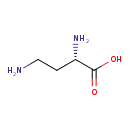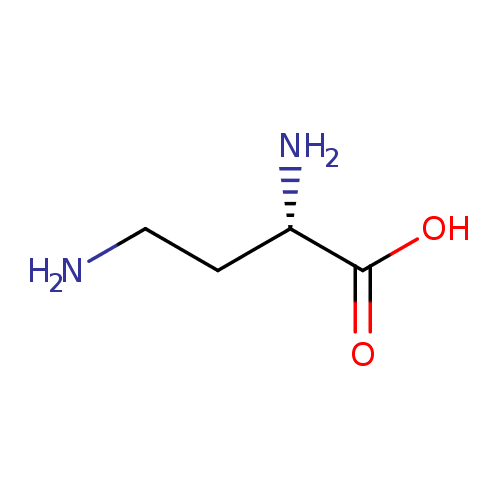|
Record Information |
|---|
| Version |
1.0 |
|---|
| Update Date |
1/22/2018 11:54:54 AM |
|---|
|
Metabolite ID | PAMDB120496 |
|---|
|
Identification |
|---|
| Name: |
L-2,4-diaminobutanoate |
|---|
| Description: | Conjugate acid of L-2,4-diaminobutyric acid. |
|---|
|
Structure |
|
|---|
| Synonyms: | - diaminobutyrate
- 2,4-diamino-L-butyrate
- L-2,4-diaminobutyrate
- L-2,4-diaminobutyric acid
|
|---|
|
Chemical Formula: |
C4H11N2O2 |
|---|
| Average Molecular Weight: |
119.143 |
|---|
| Monoisotopic Molecular
Weight: |
120.089874 |
|---|
| InChI Key: |
OGNSCSPNOLGXSM-VKHMYHEASA-O |
|---|
| InChI: | InChI=1S/C4H10N2O2/c5-2-1-3(6)4(7)8/h3H,1-2,5-6H2,(H,7,8)/p+1/t3-/m0/s1 |
|---|
| CAS
number: |
1758-80-1 |
|---|
| IUPAC Name: | (2S)-2,4-diazaniumylbutanoate |
|---|
|
Traditional IUPAC Name: |
2,4-diaminobutyric acid |
|---|
| SMILES: | C(CC(C([O-])=O)[N+])[N+] |
|---|
|
Chemical Taxonomy |
|---|
|
Taxonomy Description | This compound belongs to the class of chemical entities known as l-alpha-amino acids. These are alpha amino acids which have the L-configuration of the alpha-carbon atom. |
|---|
|
Kingdom |
Chemical entities |
|---|
| Super Class | Organic compounds |
|---|
|
Class |
Organic acids and derivatives |
|---|
| Sub Class | Carboxylic acids and derivatives |
|---|
|
Direct Parent |
L-alpha-amino acids |
|---|
| Alternative Parents |
|
|---|
| Substituents |
- L-alpha-amino acid
- Amino fatty acid
- Fatty acid
- Fatty acyl
- Amino acid
- Carboxylic acid
- Monocarboxylic acid or derivatives
- Amine
- Hydrocarbon derivative
- Organic oxide
- Primary amine
- Organooxygen compound
- Organonitrogen compound
- Organopnictogen compound
- Primary aliphatic amine
- Organic oxygen compound
- Carbonyl group
- Organic nitrogen compound
- Aliphatic acyclic compound
|
|---|
| Molecular Framework |
Aliphatic acyclic compounds |
|---|
| External Descriptors |
|
|---|
|
Physical Properties |
|---|
| State: |
Solid |
|---|
| Charge: | 1 |
|---|
|
Melting point: |
Not Available |
|---|
| Experimental Properties: |
| Property | Value | Reference |
|---|
| Melting Point | Not Available | Not Available | | Boiling Point | Not Available | Not Available | | Water Solubility | Not Available | Not Available | | LogP | Not Available | Not Available |
|
|---|
| Predicted Properties |
|
|---|
|
Biological Properties |
|---|
| Cellular Locations: |
Not Available |
|---|
| Reactions: | |
|---|
|
Pathways: |
Not Available |
|---|
|
Spectra |
|---|
| Spectra: |
|
|---|
|
References |
|---|
| References: |
Not Available |
|---|
| Synthesis Reference: |
Not Available |
|---|
| Material Safety Data Sheet (MSDS) |
Not Available |
|---|
|
Links |
|---|
| External Links: |
|
|---|


